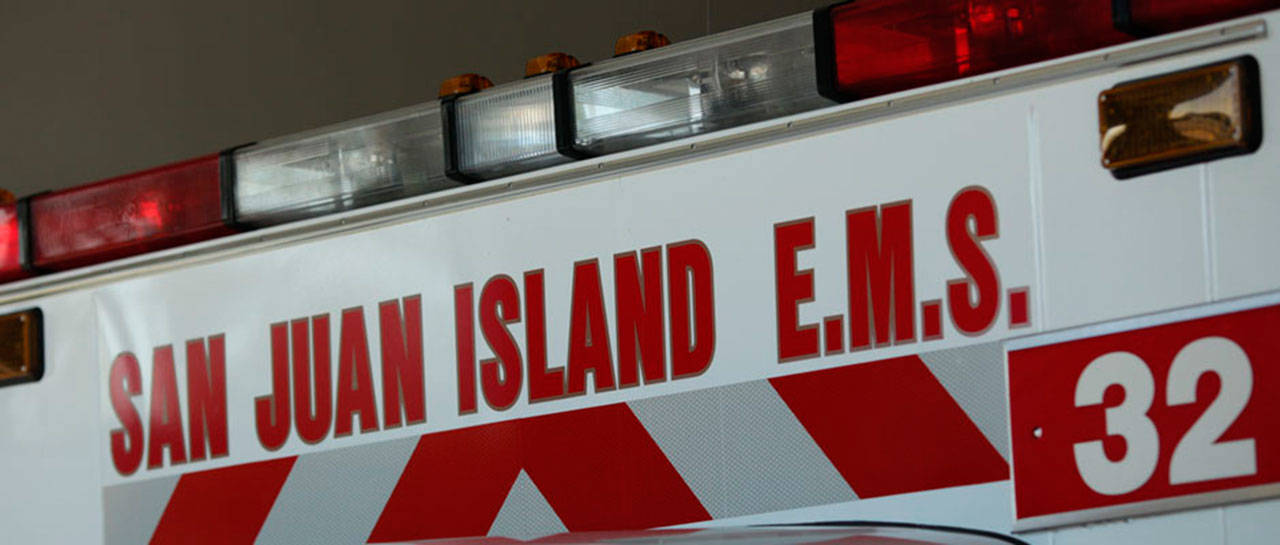Correction: Originally this article stated that there would be a projected $6,000 surplus at the end of 2017, but it is a projected $600,000.
Even after an increased tax levy in 2016, San Juan Island Emergency Medical Services still isn’t out of the woods.
By this February, San Juan Island EMS could join San Juan Island Fire and Rescue to make up for needed revenue.
That’s what EMS Chief Jerry Martin suggested at the San Juan Island Public Hospital District 1 meeting on Wednesday, Oct. 25, right before the board accepted his letter of resignation.
“Our budget will work for the next few years, but there are definitely advantages to move EMS back over to fire,” said Martin.
Martin told the Journal, EMS separated from the fire department about 30 years ago but didn’t have details as to why.
The public hospital district oversees the EMS budget, which local CPA Chris Compton — who works with the department — said is underfunding capital reserves. Finances, he added, were “not adequately monitored” in past years.
Hospital District Commissioner Chairman Bill Williams explained that the last EMS levy helped the department stay afloat. The six-year levy, which passed in 2016, is set to the state’s maximum amount for a stand-alone EMS department.
“We wouldn’t have gotten here without doing that, but it’s not guaranteed we can do it for a long period of time if we don’t come up with something,” said Williams.
That “something,” suggested Martin, is to join the island’s fire district for the community to “reap the benefits.” Hospital District Commissioner Michael Edwards explained that EMS services could receive up to roughly $1.50 more per $1,000 of assessed property value under a fire district tax levy.
“Not that I want to tax people that, but at least there’s the potential,” he said.
Martin noted that a contract with the fire district could be written by February, coinciding with his last day on Feb. 1.
Martin, who submitted his resignation letter to the commission’s chairman and superintendent the night before the meeting, told the Journal “personal reasons were at the heart” of his decision.
At the meeting, he explained the difficulty in the EMS budget. For instance, when Martin joined the department in 2016, he said there were $4.1 million in the department’s accounts receivable, which is now down to $950,000.
“I want to call it an accomplishment, but it’s not an accomplishment,” said Martin.
Hospital District Commissioner Monica Harrington said that most of the collections were probably reimbursements for medical flights, which the department stopped offering in early 2016. Collections for those payments are almost done, while many Medicaid and Medicare reimbursements are past their collection deadlines, said Harrington.
The backlog of uncollected payments made “EMS finances look rosier” than they actually were, she said, but most will likely be written off as bad debt.
“Community members should be paying attention. We need a thorough, fair, open discussion about EMS finances, including how we got here,” said Harrington.
Compton noted that only 30 percent of the original amount would be collected, at all, since it includes payments before insurance adjustments. He did, however, express concern over the budget’s lack of reserves.
“We’re budgeting for a surplus of $600,000; that’s extremely tight and quite frankly I feel uncomfortable,” he said.
Williams explained that the 2018 EMS budget is about $70,000 underbudgeted for capital reserves. The department, he said, needs to set aside $100,000 each year to account for its capital reserves for the next decade.
“Being able to put that $100,000 in next year looks doubtful; the year after that looks doubtful,” said Williams, though he and Martin both noted that the budget would work in 2018.
This year, staff bought a roughly $180,000 ambulance; next year there are few expenses; and in 2019, they plan to buy defibrillators and possibly another vehicle.
Compton also said that staff paid an unexpected $160,000 in legal fees in 2016. Harrington told the Journal this was for an investigation by the state’s attorney general office into whether EMS flight reimbursements were “appropriate.” She said the investigation began in 2015.
Martin also added that EMTs will start seven, day shifts a week, in response to a roughly 20-minute response time in September due to a lack of on-duty staff. Two EMTs will work four consecutive, 10-hour shifts starting Nov. 1.
Despite difficulties, Martin expressed gratitude to the commission.
“I want to thank you for allowing me to work for you guys and to work with the public,” he said, in a shaky voice.
He told the Journal that his two years of service has been “a wonderful experience,” noting the large community support he received when the 2016 EMS tax levy passed with 77 percent of the vote.
The 2018 EMS budget passed at the meeting. To watch the meeting, visit www.sanjuanco.com/1076/Hospital-District and view the budget below.
San Juan Island EMS Proposed Budget



